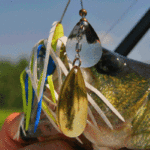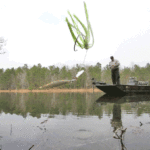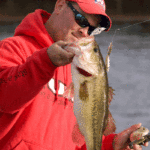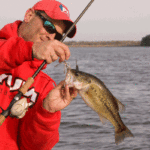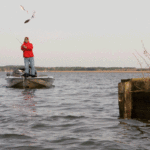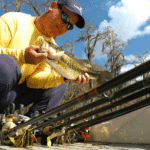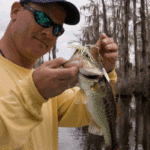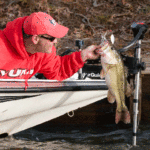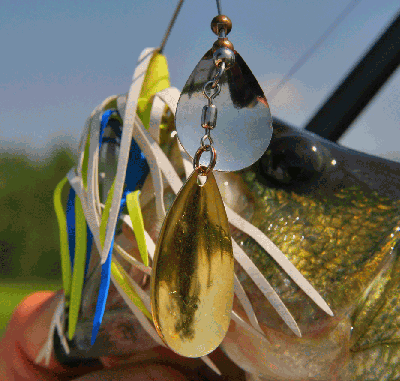
Do you know why you throw your favorite spinnerbait? Take some time to really figure that out, and you could catch more bass.
Few bass anglers give much thought about what spinnerbait they tie on the ends of their lines. Want proof? Take a look at what’s lying on the front decks of bass boats all across the Bayou State.
Odds are you’ll find 75 percent have tied on 3/8-ounce chartreuse-and-white spinnerbaits with tandem Colorado/willow-blade combinations.
The other 25 percent? According to West Monroe’s Kenny Covington, they’ll have tied on a 3/8-ounce chartreuse-and-white double-willow spinnerbait.
“But none of them know why they’re throwing either one,” Covington said. “They may know that bass are slamming spinnerbaits right now because they’re up shallow feeding on shad, but they don’t know why they have those particular kinds of spinnerbaits tied on.”
According to Covington, if those anglers took a little time to experiment with their spinnerbaits — trying different blades, different colors, changing arm lengths — they would discover that thinking outside the spinnerbait box can lead to surprisingly better catches.
Covington’s not going to get pigeonholed into fishing only one kind of bait, but he has developed a reputation of being a spinnerbait angler because he relies on them so much when fishing bass tournaments in Northeast Louisiana.
In fact, he’s used spinnerbaits to take some tournament victories the last few years at Lake D’Arbonne, Caney Lake and the Ouachita River. And the strange thing about all of these spinnerbait wins is that they all happened during November.
“In my opinion, November is the absolute best time to throw a spinnerbait if you’re bass fishing this part of the state,” Covington said. “But if you throw them the way they come out of the box, you’re not going to put as many bass in your bag.
Through several years of tinkering, Covington has created a few favorites that he picks up first when he fishes D’Arbonne, Caney or the Ouachita River during November.
All but one are name-brand spinnerbaits he customizes to fit his needs based on what bass have told them they like. The small ones are modified Mr. Hooty spinnerbaits, and the heavy ones are modified Strike King spinnerbaits.
Covington’s approach to fishing each of these three bodies of waters during November is as unique as the spinnerbaits he fishes in each.
Lake D’Arbonne
Whereas Covington would normally be heading straight to a grass flat during November with a spinnerbait at the ready, this year is going to be an exception.
He’s still going to have a spinnerbait in his hand, but he’s not going to be able to reach the grass flats this year because the lake is undergoing a scheduled drawdown.
“That means I’m going to be looking for bass to be on the shallow flats just off the main-creek channel arms up Little D’Arbonne and Corney cvreeks,” Covington said. “The best flats are going to be the ones with lots of wood cover in about 2 to 3 feet of water.”
Since the water is likely to be stained because of wind and boat activity stirring it up, Covington said he’s going to be reaching for a spinnerbait that a bass holding beside a stump is going to have no trouble finding.
“Anticipating a low and muddy lake, I’m going to make a ½-ounce chartreuse-shad-colored spinnerbait with a No. 2.5 Colorado blade in front of a No. 4 or No. 4.5 Indiana blade,” he said. “One thing about shallow, muddy water: I’ve always had better luck with bigger blades.”
Since the larger blades are key to bass finding his spinnerbait in muddy water, Covington makes sure to fish this custom job with a slow and steady retrieve. With reduced visibility, bass sometimes have a hard time locating and striking an erratically fished bait that is starting and stopping all the time.
A steady retrieve solves this problem by allowing bass to time their strike so they can nail Covington’s spinnerbait as it passes the stump. Any little variation in speed can cause them to misjudge exactly when the lure will pass by, and that creates a lot of short-striking fish that wind up jumping off even if they do get hooked.
“Not only do I want a bait with some thump on the shallow D’Arbonne flats, I want my bait to actually thump the wood cover. With a big old Indiana blade spinning around at the back of my bait, I can make that blade hit and flop off the wood as it passes by.
“That triggers a lot of strikes.”
Also, the shad are really big this time of year, and Covington contends that the No. 4.5 Indiana blade he puts on the back of this spinnerbait does a good job mimicking the size of the baitfish in the lake.
“A lot of people think the bait and the bass are just automatically going to head straight to the channels when the water falls out,” Covington said, “but that’s not always the case. As long as there are shad on those shallow, wood flats, the bass are going to be there, too.
“And this spinnerbait is going to be a great way to catch them.”
Ouachita River
Spinnerbaits work great on the Ouachita River during November, but Covington argued that before throwing one with any expectation of catching a bass, you first have to find the shad.
“That’s the No. 1 thing,” he insisted. “You got to be somewhere there are shad in order for the bass to be there, and that means heading to the backs of the creeks and river lakes this time of year.”
Rather than pulling up shallow to spawn like they do during the spring, bass in the Ouachita River pull up shallow to eat during the fall. And these fish are really bad about relating to the shad rather than the actual cover in the backs of the creeks and lakes.
Covington said that’s why some anglers struggle to find them one day when they thought they had pegged their locations the day before.
“They suspend right under the balls of shad, and wherever the shad go the bass go with them,” he explained. “Take Moon Lake, for example: You can go in there during the fall and catch all your bass right out in the open instead of by the stumps and trees. That’s why I rig up a spinnerbait that gives the fleeting impression of a shad rather than one that’s in their faces.”
Covington keeps two spinnerbaits handy when fishing the Ouachita River during November. Both look the same, but one is 3/8 of an ounce while the other is a ½-ounce model. He chooses more of a translucent skirt color like the Spot Remove skirt that War Eagle makes.
“It’s kind of a light gray with fine green and black flakes in it,” Covington described. “If it’s really clear, I go with a firecracker skirt. And on cloudy days you can’t beat blue glimmer on the river.”
He chooses his blades to finish off a spinnerbait that blends in rather than stands out by going with No. 4 and No. 4.5 silver double willows on sunny days; gold blades are best on cloudy days.
“I’m just looking to create the illusion of something swimming by,” Covington noted. “The river is what I call sneaky clear. It looks like it’s stained, but then you drop a bait in the water, and you can see it 3 feet down.
“Burning a spinnerbait that blends in through those balls of shad is as good a way to get bit on the river during November that I know of.”
Covington also takes those same spinnerbaits and fishes parallel to the bluff banks in the main river to catch all the Kentucky bass he cares to reel in. He positions his boat right up against the bluffs with his trolling motor on a medium speed and casts upstream.
“Just like back in the creeks and lakes, I keep my spinnerbait within 6 inches of the surface of the water where I can see it really well,” Covington explained. “In both spots, I can see most of the fish that hit it.”
Caney Lake
This is probably the last lake anybody would consider as a good spinnerbait lake, and that’s exactly why Covington doesn’t mind picking one up anytime he fishes Caney; he assumes that if he’s the only one throwing one, he’ll catch fish other anglers don’t even target.
“People think you’ve got to catch them deep at Caney, but that’s just not true,” Covington said. “I’ve won tournaments down there during November and December fishing spinnerbaits in 1 1/2 foot of water.”
Covington’s belief is that if he ties on a spinnerbait and runs banks that have some kind of depth change nearby then the law of averages means he’s going to be putting his bait in front of way more fish than the shaky-head guys out crawling their worms through deep brush piles.
There’s no doubt that Caney is one of those kinds of lakes that the locals believe must be fished a certain way, but Covington has proven time and time again that he can take power baits like spinnerbaits there and do very well.
“Spinnerbaits work best at Caney along the banks with a little bit of depth contour change to them,” Covington explained. “There’s usually a little bit of a change right out from a lot of those seawalls, and those walls are good places to start.”
But the absolute best banks are those with a depth change that are also getting pounded by the wind. According to Covington, bass that are so used to living in an ultra clear environment love it when the surface gets a little chop.
“It gives them a window of opportunity, and they feel free and let their guards down,” Covington said. “The chop acts as a little cover for them, so they get up there and roam around in shallow water.”
Covington builds his own spinnerbait for Caney that he calls a Ron Special after his dad came up with the concept for fishing another nearby lake when Covington was just a teenager.
“It’s just a little old 3/16-ounce head that I buy with nothing else on it,” he explained. “It’s kind of a thin, slender-shaped head that kind of moves around as it comes through the water.
“I put a No. 1 Colorado blade on the front and a No. 3 willow on the back. It winds up being a very compact spinnerbait that I can run deep or shallow.”
Covington also relies on a 1/8-ounce single-willow Stanley spinnerbait and a 3/4-ounce spinnerbait for Caney Lake. The lighter model gets the nod under calm and clear conditions, and then he pulls out the bigger versionwhen it’s really windy or he needs to make really long casts.
“And one more tip for fishing spinnerbaits at Caney,” Covington said. “The lake is getting more devoid of cover every year, so anywhere you can find a stump on a little drop-off or a log along a drop-off you’re going to find a bass.
“But just remember: When fish are on the drops, it doesn’t take much. If you’re in 2 feet of water, a drop is 3 feet.”
Covington has obviously put a lot of thought into his spinnerbaits, and he thinks it’s time you do, too. Building a better spinnerbait won’t make the world beat a path to your door, but it will make the bass bite better.
And once you know why you’re throwing what you’ve got tied on, you’ll start thinking more and more outside the spinnerbait box.
